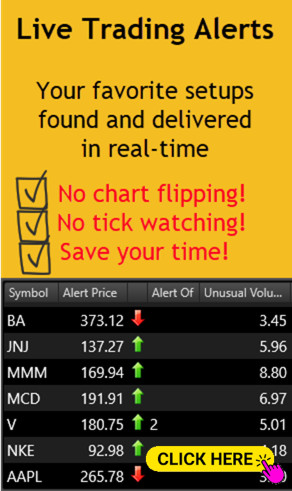Trading the T-Line, also known as the trigger line or trend line, works well for all trading plans and investment strategies. If you want to embrace this strategy, look into (what I call) the T-Line run. T-Line runs can be very profitable if you know how to identify them and use them properly. Curious? Read on to learn more about the types of T-Line run, get some helpful application tips, and learn how to confirm your trades to make smart entrances and exits.
The T-Line Run
As you begin trading the T-Line, keep an eye out for T-Line runs. A T-Line run occurs when the price action of a stock is trading above the T-Line, and the lows are holding above the T-Line and they never close below the T-Line. This is a bullish T-Line run, because price action is running along the T-Line. The opposite is true for a bearish T-Line run. This occurs when the price action of a stock is trading below the T-Line, and the highs of that time frame are just tapping or close to the T-Line, but the stock never closes above the T-Line. On the chart, this looks more like a “monkey bar run.”
One thing to be aware of with a T-Line run is that as the price action moves away from the T-Line, the more likely it is that it will fall/rise back to test the T-Line. Sometimes a T-Line run will be in effect and get too far from the T-Line—it will trade sideways for a few days until it comes back to the T-Line, testing it. Other times, it will happen dramatically in one day if it is too far from the T-Line.
T-Line Confirmation
T-Line confirmation is important when you’re trading the T-Line because price action can cross the T-Line back and forth during the day, but that doesn’t mean that it is time to exit a position. Use these three observations to confirm that you’re making a smart trading decision:
- The first confirmation is at the close. Did my long position close above the T-Line? If that long position closed below the T-Line, it still needs to confirm the following day.
- The second confirmation is the following day’s close. Did the position trade and close back above the T-Line, or did it continue trading down?
- The third confirmation is other signs. Is this just a pullback in a trend? Is it forming some other type of pattern?
Conclusion
Trading the T-Line has dramatically changed the way I approach investing. Perhaps more importantly, it has helped me succeed. I went from winning some of the time to winning most of time.
In fact, trading the T-Line is so reliable that you could trade using only the T-Line, opening and closing positions as they close above and below the trigger line. However, if you want the T-Line strategy to work for you, it is essential that you use it correctly. You need to consider all of the components of a chart and confirm your ideas before you react. With some practice, patience, and trial and error, you can learn how to make the most out of T-Line runs.




